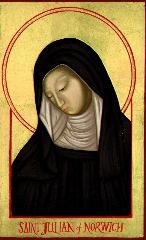UMILTA WEBSITE || OLIVELEAF WEBSITE || JULIAN OF NORWICH, TEXT AND CONTEXTS,
WEBSITE || BIRGITTA OF SWEDEN, REVELATIONES,
WEBSITE || CATALOGUE AND PORTFOLIO
(HANDCRAFTS, BOOKS ) || BOOK
REVIEWS || BIBLIOGRAPHY || FLORIN WEBSITE ©1997-2024
JULIA BOLTON HOLLOWAY
IMPOSSIBLE SAINT
SANTA RITA OF CASCIA
 anta Rita's dates
are medieval, 1381-1457, but her canonization modern, 1900;
hence we lack contemporary pictures of her. I learned of her
from a battered wife, concerned about battered wives, asking
me her story, since her cult is everywhere in Florence,
women praying before her picture, where she is seen as a
pre-Vatican II nun, in all the churches. I give it, too,
because the Tablet's editors kept saying, 'But there
aren't other married women saints'.
anta Rita's dates
are medieval, 1381-1457, but her canonization modern, 1900;
hence we lack contemporary pictures of her. I learned of her
from a battered wife, concerned about battered wives, asking
me her story, since her cult is everywhere in Florence,
women praying before her picture, where she is seen as a
pre-Vatican II nun, in all the churches. I give it, too,
because the Tablet's editors kept saying, 'But there
aren't other married women saints'.
There are so many, besides St Birgitta of Sweden. There are Saints
Felicitą and Perpetua. There is St
Cecilia, married to St Valerian, both
martyred in Rome. There is St Paula, who, with her
daughter, St Eustochium, supported and worked with St Jerome translating the Vulgate from
Hebrew and Greek into Latin. There is Christina
of Markyate. There is Blessed Angela of Foligno.
There is St Umilta` of Faenza. There
is St Francesca Romana. And there
is St Rita. Perhaps it is because I collect women who were
married and who became nuns that I find them.
It was an Italian, an unbeliever, who
told me he believed in Santa Rita, because of a story during the
World War of a soldier shot through many times, fleeing from the
enemy, submerging himself under water with a reed to breathe,
and praying to St Rita. And his life was spared. I saw her
shrine in Cascia, in Umbria, with the teller of that tale, a
fine modern church amidst a desolate earthquake-destroyed
landscape. His marriage reflected hers, but his wife died young.
Her marriage reflected mine. And that of the other teller of her
tale to me. So it was the Italian perpetrator who gave me the
explanation to give concerning her to the English victim.
Telling me why she is so popular today in Italy amongst
everyone, men as well as women. An underground saint, an
unacceptable saint, but with a greater following in Florence
than any other. A people's saint.
Her story.
She was born near Spoleto. She wanted to be a nun but her
family married her young to a man of most violent temper who
abused her and their two children. Rita struggled to remain
faithful to her husband and to God. After twenty years of hell
her husband was stabbed by an enemy, but before dying he
repented because of Rita's prayers for him. Soon afterwards,
her two sons, brutalized by their father, also died. She
sought to realize her childhood vocation but monastic orders
do not lightly accept women who are of the married state.
Finally she was admitted by Augustinian nuns at Cascia in
Umbria. Her great devotion was to the Passion of Christ,
suffering herself the wound of the thorn. She fasted, prayed,
was greatly obedient and practised charity.
Her name, Rita, is also that of Ruth,
the gentile ancestress of Christ. Her symbol is the rose petal,
which she shares with St Therese of Lisieux. But she is also an
Oliveleaf Saint, one who consoles those utterly without power,
who are abused by those having power. To such she seems
despicable. To us she is balm, a woman mirroring Christ against
Herod. Her day, May 22, in the month of Mary.
Like St Jude,
Christ's brother, she is Patron of Impossible Causes. She is
our patron, of damaged wives and children, abused by men in authority, those misusing God's
power. Even they revere her. To whom an Anglican bishop's wife
lit candles and prayed.
UMILTA WEBSITE || OLIVELEAF WEBSITE || JULIAN OF NORWICH, TEXT AND CONTEXTS,
WEBSITE || BIRGITTA OF SWEDEN,
REVELATIONES, WEBSITE || CATALOGUE
AND
PORTFOLIO (HANDCRAFTS, BOOKS ) || BOOK
REVIEWS || BIBLIOGRAPHY ||
FLORIN WEBSITE ©1997-2024
JULIA BOLTON HOLLOWAY
 Oliveleaf
Website
Oliveleaf
Website
 anta Rita's dates
are medieval, 1381-1457, but her canonization modern, 1900;
hence we lack contemporary pictures of her. I learned of her
from a battered wife, concerned about battered wives, asking
me her story, since her cult is everywhere in Florence,
women praying before her picture, where she is seen as a
pre-Vatican II nun, in all the churches. I give it, too,
because the Tablet's editors kept saying, 'But there
aren't other married women saints'.
anta Rita's dates
are medieval, 1381-1457, but her canonization modern, 1900;
hence we lack contemporary pictures of her. I learned of her
from a battered wife, concerned about battered wives, asking
me her story, since her cult is everywhere in Florence,
women praying before her picture, where she is seen as a
pre-Vatican II nun, in all the churches. I give it, too,
because the Tablet's editors kept saying, 'But there
aren't other married women saints'. 
